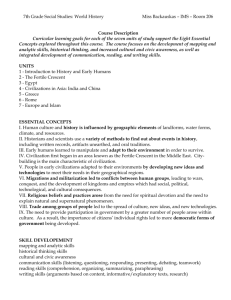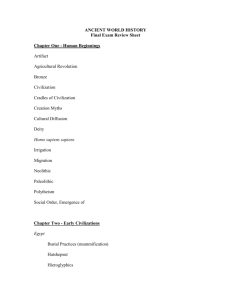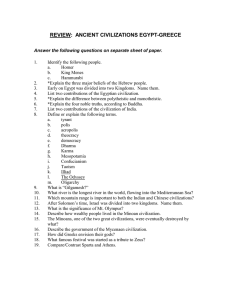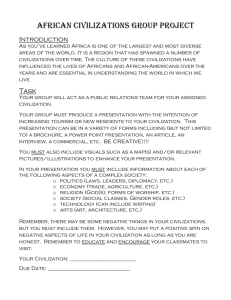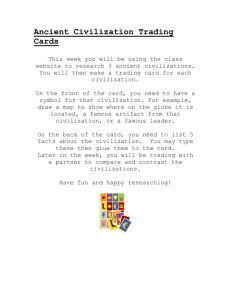t3e
advertisement
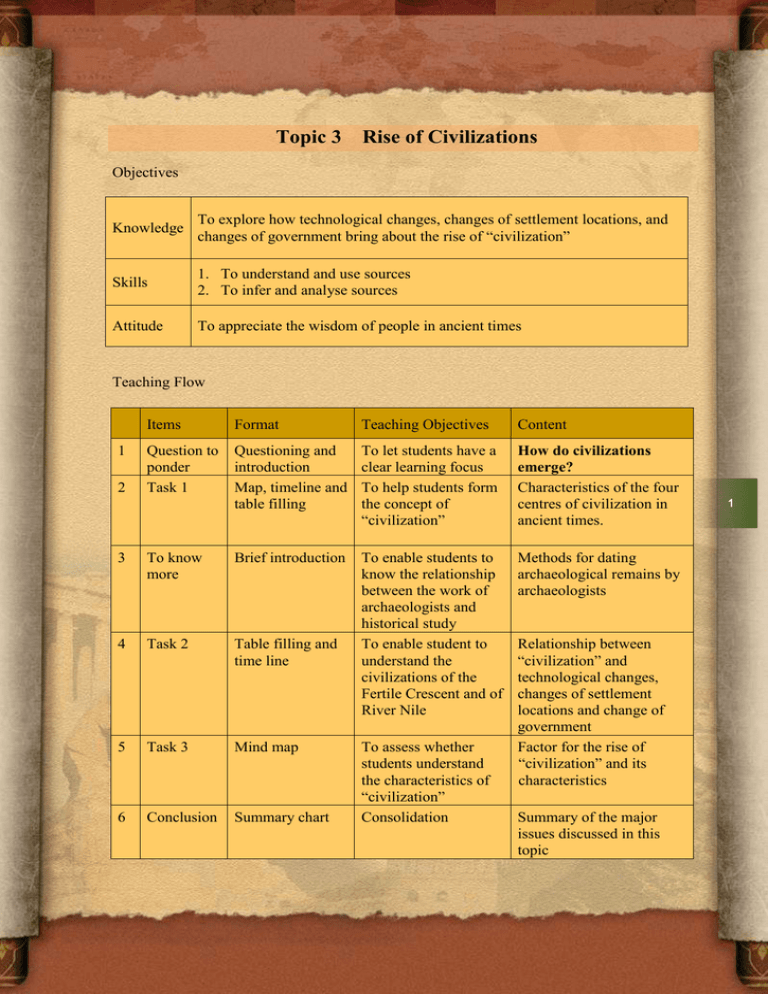
Topic 3 Rise of Civilizations Objectives Knowledge To explore how technological changes, changes of settlement locations, and changes of government bring about the rise of “civilization” Skills 1. To understand and use sources 2. To infer and analyse sources Attitude To appreciate the wisdom of people in ancient times Teaching Flow 1 2 Items Format Teaching Objectives Content Question to ponder Task 1 Questioning and introduction Map, timeline and table filling To let students have a clear learning focus To help students form the concept of “civilization” How do civilizations emerge? Characteristics of the four centres of civilization in ancient times. To enable students to know the relationship between the work of archaeologists and historical study To enable student to understand the civilizations of the Fertile Crescent and of River Nile Methods for dating archaeological remains by archaeologists 3 To know more Brief introduction 4 Task 2 Table filling and time line 5 Task 3 Mind map 6 Conclusion Summary chart To assess whether students understand the characteristics of “civilization” Consolidation Relationship between “civilization” and technological changes, changes of settlement locations and change of government Factor for the rise of “civilization” and its characteristics Summary of the major issues discussed in this topic 1 Question to ponder How did civilizations emerge? Task 1 Looking for traces of “civilizations” of the ancient times Source A Below shows information about the four major ancient civilizations: 2 Source:History, Curriculum Development Institute, Education Bureau 1. Fertile Crescent Civilization: about 4000 BC 2. Nile River Civilization: about 3500 BC 3. Indus Valley Civilization: about 3000 BC 4. Yellow River Civilization: about 1760 BC Topic 3 Rise of Civilizations With reference to Source A, mark the names of the earliest human civilizations on the time line below, and add the era: a b c d Suggested answers: a Beginning of Fertile Crescent Civilization (about 4000 BC) b Beginning of Nile River Civilization (about 3500 BC) c Beginning of Indus Valley Civilization (about 3000 BC) d Beginning of Yellow River Civilization (about 1760 BC) To know more 3 In general, there are two methods for dating archaeological remains. The first method is carbon-dating. Carbon has always been found in the air and supports life (both animals and plants). Most carbon atoms are stable (not changing over time), but a tiny portion (0.0000000001 percent), known as Carbon 14, is radio-active. That is to say, this carbon atom decays over time: every 5730 years, it loses half its mass. By examining the proportion of carbon 14 in a sample of living organism (wood or bone) using very fine equipment, the archaeologist can work out the approximate age at which it died. The other method is to record very carefully the layers in which material objects are found and to compare layers of objects in different locations. If earth has not been disturbed, the older objects are found in the lower layers. So, by noting where the layers are, and what objects have been found in each, and comparing the styles of these objects, the archaeologist is able to reconstruct the history of how these objects are transformed over time. That record can be used as a time line for measuring changes in different locations. Task 2: Exploring the Fertile Crescent Civilization (Fertile Crescent is also known as Mesopotamia) and the Nile River Civilization Uruk of nowadays Iran is one of the oldest cities discovered by archaeologists. Consider the following concluding article about archaeological findings in Uruk so as to understand how civilizations emerge. Source B For thousands of years, southern Mesopotamia (ancient Iraq) was home to hunters, fishers, and farmers, exploiting fertile soil, rivers, and abundant animals. By around 3200 BC, the largest settlement in southern Mesopotamia, if not the world, was Uruk. Uruk was a true city dominated by monumental mud-brick buildings decorated with mosaics of painted clay cones embedded in the walls, and extraordinary works of art. Large-scale sculpture in the round and relief carving appeared for the first time, together with metal casting. Simple pictographs were drawn on clay tablets to record the management of goods and the allocation of workers’ rations. These pictographs are the precursors of later cuneiform writing. Cities such as Uruk continued to expand. During the Early Dynastic period (2900–2350 BC), when city-states dominated Mesopotamia, the city rulers gradually grew in importance and increasingly sought luxury materials to express their power. These goods, often from abroad, were acquired either by trade or conquest. 4 Source: Department of Ancient Near Eastern Art. “Uruk: The First City”. In Timeline of Art History. New York: The Metropolitan Museum of Art, 2000- .http://www.metmuseum./org/toah/hd/uruk/hd_uruk.htm 1. Identify from Source A the main characteristics of the Fertile Crescent Civilization Description Main Characteristics of the Evidence Categories Fertile Crescent Civilization Settlement Near rivers Fertile land, river, and adequate animals Communication Writing (and its function) Hieroglyph Technology Metal There were carved objects made of metallic casted pieces. Governance Government Dynasties, rulers of the cities or expedition 2. Which economic activity do you think was the most important in enabling the people of Uruk to survive, hunting, fishing, or agriculture? Explain your answer with reference to Source B. Suggested answer: According to Source B, the words “exploiting fertile soil, rivers” suggest that the most important activity of people at ancient times was agriculture. It was because fertile land and abundant water supply favoured the sustainable development of agriculture. Topic 3 Rise of Civilizations 3. Study the items below that were discovered in Egypt. They can be dated back to 3000 B.C., a time before the pyramids were built. Source C Source D Top Top Middle Middle Bottom Bottom 5 Source: http://commons.wikimedia.org/wiki/Image:NarmerPalette_ROM.jpg. a. Telling a story together: Form into groups to describe the pictures in Sources C and D. Explain what the Sources reflect. Suggested Answers: Top part of the palette Source C Source D Bull’s head Bull’s head ruler: a man in a procession, while 10 headless corpses are lying on one side. Hints from Teacher / Background Information Symbolized the king’s power. Middle part of the palette Source C Source D A man is grasping another man’s hat. Who is this man? Crown / Ruler Strange appearance; animals with their necks entwined together What is the animal to the top-right part of the man? Eagle / Bird Hints from Teacher / Background Information Symbolizes: The crown in Source C belonged to upper Egypt (i.e. south part), while the crown in Source D belonged to lower Egypt. Therefore, Source C shows that the king of upper Egypt conquered some enemies, and Source D shows that he was in a triumphant procession after becoming the king of lower Egypt. The bird on the left diagram is called Horus and it represents the king. In Source D, the strange looking animals with their necks entwine probably represent the joining of upper and lower Egypt. What is below the animal? Papyrus plants The papyrus plants show that the war occurred in the northern part of the Nile River. 6 Bottom part There are two of the men running palette A bull is trampling enemies and taking down a city wall. What activity is going on as reflected? A scene of victory War location: Northern part of the Nile River A war scene b. Find from Sources C and D the main characteristics of the ancient Egyptian civilization. Teaching Tips As Task 2 already shows the main characteristics of a civilization, the teacher may decide, based on the students’ ability, whether to provide the table below for their group discussion. Topic 3 Rise of Civilizations Suggested answers: Main Characteristics of the ancient Nile River Evidence Civilization Settlement Near a river The Nile River City A city has been set up. You can see from the left picture the enemies are running away; on the right picture there are bulls attacking the wall of the city. Communication Writing There were already traces of writing, because on the right picture there is a mark between the heads of the bulls on the top of the palette. Historians of Egyptian history tell us that the mark there have got the king’s name. Technology Metal The objects shown in Source C and Source D were made of metal. Description Category Task 3: What are the characteristics of “civilization”? After completing the above task, what do you think are the characteristics of “civilization”? Fill in the mind map below. 7 ? Settlement along river bank / valley ? Characteristics of “civilizations” ? ? ? Suggested answers: Writing already invented/Religion already developed/ Metal tools already used / Government already established/City already formed/Other reasonable answers Conclusion “Civilization” is one of those words which are impossible to define. Historians use it to indicate the beginning of writing, cities, government and the use of tools. The rise of civilization is a very long process; it indicates the gradual development of large numbers of people living together, using their own inventions to control their surroundings. The area around Iran and Iraq, known to historians as Mesopotamia, has yielded records of many ancient cities. Other parts of the world where cities appeared by 2000 BC include: Egypt, the Indus Valley (in India), and North China. At about 3,000 BC, cities, writing, governments and, in some places, the use of bronze began to appear in some parts of the world. They created a new environment for human beings living together. From that time on, we begin to have written records of history. 8 Summary Chart 1. Technological changes: e.g. use of bronze 2. Change of settlement location: e.g. living in cities. 3. Change of government: e.g. led by rulers. Contributed to the rise of civilizations.


